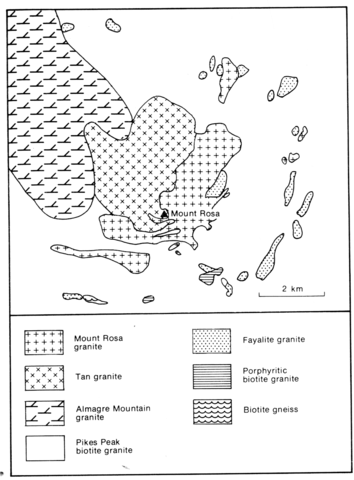stripes
The Mount Rosa granite lies at the southern end of the composite Pikes Peak batholith. The batholith is composed principally of biotite and hornblende granites but quartz syenites and fayalite granites also occur (Barker et al., 1975). The Mount Rosa granite forms irregular sheets cutting, and chilled against, Pikes Peak biotite granite except along the northwestern side where it cuts the Tan granite, which contains biotite but also a little riebeckite and astrophyllite. Small masses of fayalite granite lie to the east and the southeast. The Mount Rosa granite (Gross and Heinrich, 1965) consists of quartz, microcline perthite, albite-oligoclase, riebeckite or fluor-riebeckite, arfvedsonite and astrophyllite; accessory minerals include aegirine, biotite, zircon, ilmenorutile, pyrochlore, monazite, bastnaesite, fluorite and pyrite. Peralkaline pegmatites are particularly abundant to the west and southeast of the Mount Rosa granite (see Gross and Heinrich, 1966a, Fig. 1) and have produced a wide range of minerals, including numerous rare fluorides, which have been described in a number of papers (cited in Gross and Heinrich, 1966a). Lamprophyres including aegirine and riebeckite-bearing varieties are numerous (Gross and Heinrich, 1966b). Analyses of rocks will be found in Gross and Heinrich (1965) and of rocks and minerals in Barker et al. (1975).
BARKER, F., WONES, D.R., SHARP, W.N. and DESBOROUGH, G.A. 1975. The Pikes Peak batholith, Colorado Front Range, and a model for the origin of the gabbro-anorthosite-syenite-potassic granite suite. Precambrian Research, 2: 97-160.
GROSS, E.B. and HEINRICH, E.W. 1965. Petrology and mineralogy of the Mount Rosa area, El Paso and Teller Counties, Colorado. I. The granites. American Mineralogist, 50: 1273-95.
GROSS, E.B. and HEINRICH, E.W. 1966a. Petrology and mineralogy of the Mount Rosa area, El Paso and Teller Counties, Colorado. II. Pegmatites. American Mineralogist, 51: 299-323.
GROSS, E.B. and HEINRICH, E.W. 1966b. Petrology and mineralogy of the Mount Rosa area, El Paso and Teller Counties, Colorado. III. Lamprophyres and mineral deposits. American Mineralogist, 51: 1433-42.
HEDGE, C.E. 1970. Whole-rock Rb-Sr age of the Pikes Peak
batholith, Colorado. Professional Paper, United States Geological Survey, 700-B: 86-9

